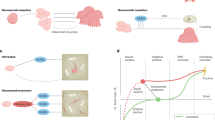Abstract
Bone destruction is mediated by osteoclasts, whose formation, function, and survival requires the receptor activator of NF-kB ligand (RANKL). Denosumab is a fully human monoclonal antibody to RANKL, thereby inhibiting osteoclast-mediated bone destruction, and blocks the vicious cycle of cancer-mediated bone disease. In breast cancer patients with bone metastases, denosumab was superior to zoledronic acid in delaying time to first on-study skeletal-related event (SRE; HR = 0.82; P = 0.01 superiority) and time to first and subsequent on-study SREs (HR = 0.77; P = 0.001). Overall survival, disease progression, and serious adverse events were similar between groups.
Similar content being viewed by others
References
Papers of particular interest, published recently, have been highlighted as: • Of importance
Coleman RE: Clinical features of metastatic bone disease and risk of skeletal morbidity. Clin Cancer Res 2006, 12:6243s–6249s.
Lipton A, Cook RJ, Major P, et al.: Zoledronic acid and survival in breast cancer patients with bone metastases and elevated markers of osteoclast activity. Oncologist 2007, 12:1035–1043.
Rodan GA: The development and function of the skeleton and bone metastases. Cancer 2003, 97:726–732.
Roodman GD: Mechanisms of bone metastasis. N Engl J Med 2004, 350:1655–1664.
Lacey DL, Timms E, Tan HL, et al.: Osteoprotegerin ligand is a cytokine that regulates osteoclast differentiation and activation. Cell 1998, 93:165–176.
Lacey DL, Tan HL, Li J, et al.: Osteoprotegerin ligand modulates murine osteoclast survival in vitro and in vivo. Am J Pathol 2000, 157:435–448.
Simonet WS, Lacey DL, Dunstan CR, et al.: Osteoprotegerin is a novel secreted protein involved in the regulation of bone density. Cell 1997, 89:309–319.
Fuller K, Wong B, Fox S, et al.: TRANCE is necessary and sufficient for osteoblast-mediated activation of bone resorption in osteoclasts. J Exp Med 1998, 188:997–1000.
Yasuda H, Shima N, Nakagava N, et al.: Osteoclast differentiation factor is a ligand for osteoprotegerin in osteoclastogenesis-inhibitory factor and is identical to TRANCE/RANKL. Proc Natl Acad Sci USA 1998, 95:3597–3601.
Yasuda J, Shima N, Nakagawa N, et al.: Identity of osteoclastogenesis inhibitory factor (OCIF) and osteoprotegerin (OPG): a mechanism by which OPG:OCIF inhibits osteoclastogenesis in vitro. Endocrinology 1998, 139:1329–1337.
Yasuda H, Shima N, Nakagawa N, et al.: A novel molecular mechanism modulating osteoclast differentiation and function. Bone 1999, 25:109–113.
Blair JM, Zhou H, Seibel MJ, et al.: Mechanisms of disease roles of OPG, RANKL and RANK in the pathophysiology of skeletal metastasis. Nat Clin Pract Oncol 2006, 3:41–49.
Clines GA, Guise TA: Hypercalcemia of malignancy and basic research on mechanisms responsible for osteolytic and osteoblastic metastasis to bone. Endo Relat Cancer 2005, 12:549–583.
Guise TA, Mohammad KS, Clines G, et al.: Basic mechanisms responsible for osteolytic and osteoblastic bone metastases. Clin Cancer Res 2006, 12:6213s–6216s.
Shapiro CL, Manoola J, Lbeoff M: Ovarian failure after adjuvant chemotherapy is associated with rapid bone loss in women with early-stage breast cancer. J Clin Oncol 2001, 19:3306–3311.
• Hadji P, Ziller M, Kieback DG, et al.: Effects of exemestane and tamoxifen on bone health within the Tamoxifen Exemestane Adjuvant Multicentre (TEAM) trial: results of a German, 12-month, prospective, randomized substudy. Ann Oncol 2009, 20:1203–1209. This study highlights the bone loss that accompanies treatment with an aromatase inhibitor.
Mincey GA, Duh MS, Thomas SK, et al.: Risk of cancer treatment-associated bone loss and fractures among women with breast cancer receiving aromatase inhibitors. Clin Breast Cancer 2006, 7:127–132.
• Eastell R, Adams JE, Coleman RE, et al.: Effect of anastrozole on bone mineral density: 5-year results from the anastrozole, tamoxifen alone or in combination trial. J Clin Oncol 2008, 26:1051–1057. This article details the importance of bone loss associated with long-term treatment (5 years) with an aromatase inhibitor.
Morony S, Capparelli C, Sarosi I, et al.: Osteoprotegerin inhibits osteolysis and decreases skeletal tumor burden in syngeneic and nude mouse models of experimental bone metastasis. Cancer Res 2001, 61:4432–4436.
Lipton A, Steger GG, Figueroa J, et al.: Randomized active-controlled phase II study of denosumab efficacy and safety in patients with breast cancer-related bone metastases. J Clin Oncol 2007, 25:4431–4435.
• Fizazi K, Lipton A, Mariette X, et al.: Randomized phase II trial of denosumab in patients with bone metastases from prostate cancer, breast cancer, or other neoplasms after intravenous bisphosphonates. J Clin Oncol 2009, 27:1564–1572. This article reports results of a trial comparing denosumab with continued zoledronic acid in patients who have high bone resorption on bisphosphonate therapy.
• Ellis GK, Bone HG, Chlebowski R, et al.: Randomized trial of denosumab in patients receiving adjuvant aromatase inhibitors for nonmetastatic breast cancer. J Clin Oncol 2008, 26:4875–4882. This article found that denosumab prevents loss of BMD associated with aromatase inhibitor therapy.
Hosking D, Chilvers CE, Christiansen C, et al.: Prevention of bone loss with alendronate in postmenopausal women under 60 years of age. Early Postmenopausal Intervention Cohort Study Group. N Engl J Med 1998, 338:485–492.
• Stopeck AT, Lipton A, Body JJ, et al.: Denosumab compared with zoledronic acid for the treatment of bone metastases in patients with advanced breast cancer: A randomized, double-blind study. J Clin Oncol 2010, In press. This article reports results from a phase 3 trial comparing denosumab versus zoledronic acid in patients with breast cancer and bone metastases.
Disclosure
A. Lipton: consultant for Amgen, Novartis; expert testimony for Novartis; honoraria from Amgen, Novartis; laboratory research support from Novartis.
Author information
Authors and Affiliations
Corresponding author
Rights and permissions
About this article
Cite this article
Lipton, A. Denosumab in Breast Cancer. Curr Oncol Rep 13, 1–4 (2011). https://doi.org/10.1007/s11912-010-0135-y
Published:
Issue Date:
DOI: https://doi.org/10.1007/s11912-010-0135-y




